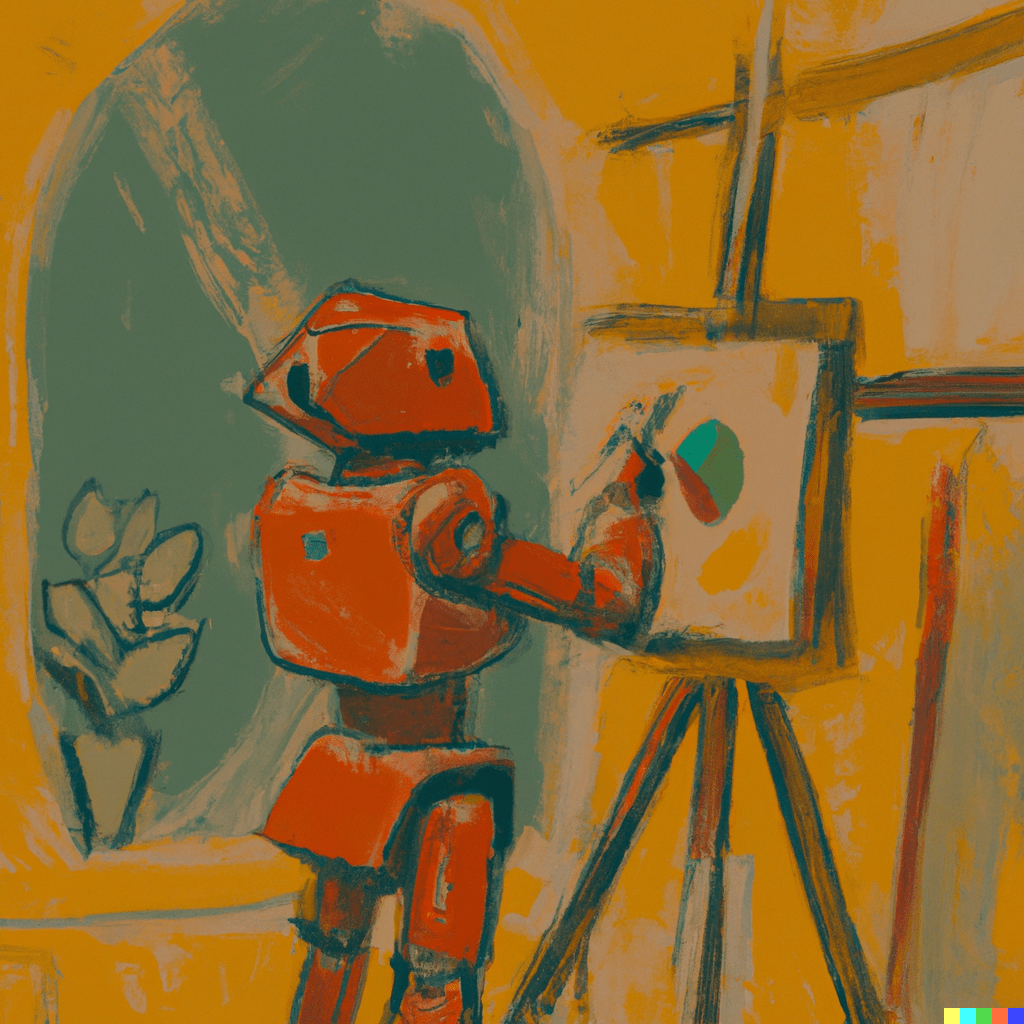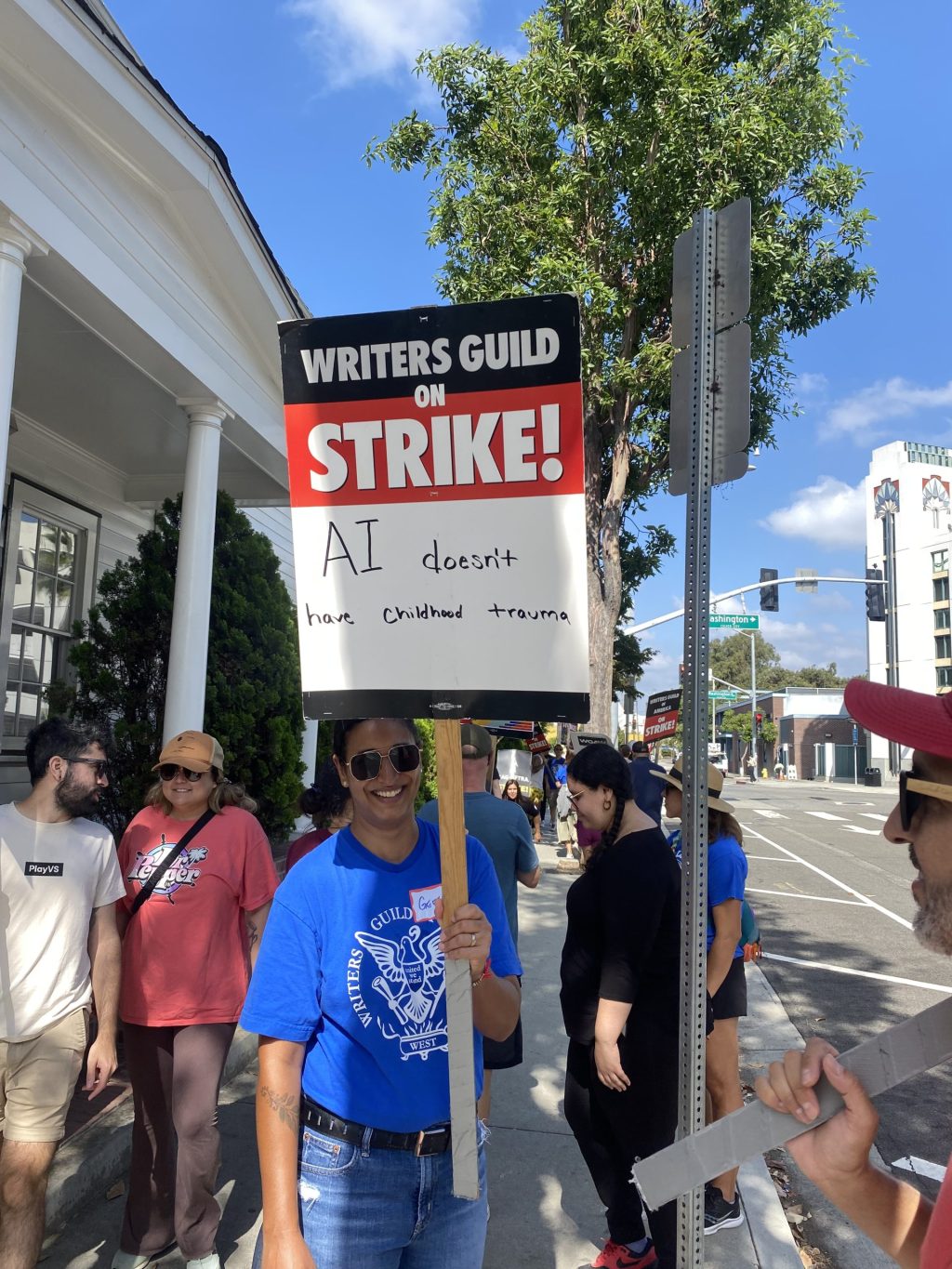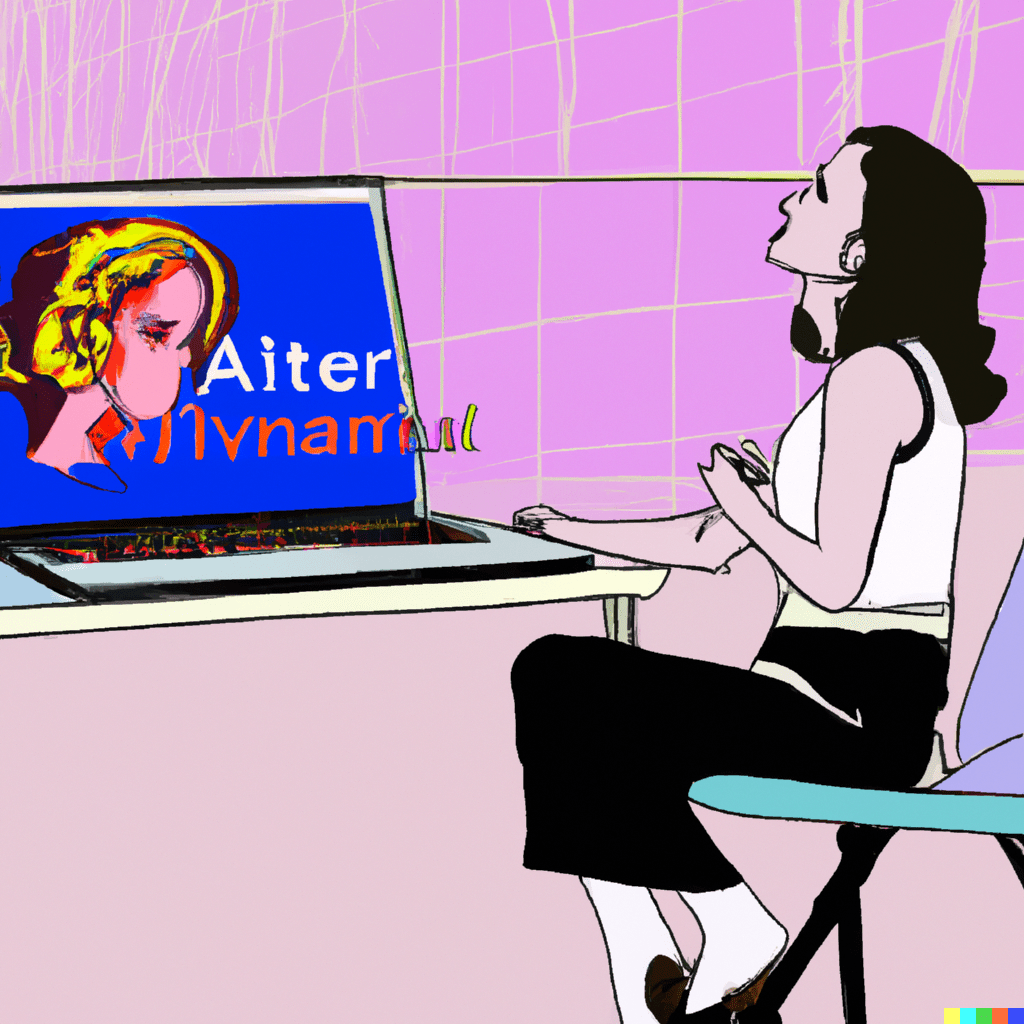When opening Twitter — now X— TikTok or Instagram Reels, one can see videos like “SpongeBob” characters singing “I Want it That Way,” or the Taylor Swift-inspired images created with Artificial Intelligence, or A.I., becoming more prevalent.
While A.I. art has existed for years, new technology has made its art more realistic than ever, according to Wired. A.I. art has become more pervasive and played a role in the concluded WGA and ongoing SAG-AFTRA strikes, according to previous Graphic reporting.
As the prevalence of A.I. art increases, the question remains — is the existence of A.I. art just another tool or the end of art as people know it?
“In general, this is a question that the artist or the creator has to answer for himself or herself: Am I trying to take shortcuts or cut corners?” said Garett Pendergraft, Blanche E. Seaver professor of Philosophy and Philosophy program director. “Am I trying to get the output or the product faster or more easily than I otherwise could?”
Inputs and Outputs
Jesse Cha, Keck scholar and visiting assistant professor of Computer Science, said when looking at generative A.I. art, one can look at it in the form of data that is input and then the image itself, or output, through recalling the data.
“When I see A.I. art, I immediately think about what kind of model was used to make that art and also what kind of data or image or collection of images were used to make that art,” Cha said.
A.I. art can also have robotic implications — for example, Sun Yuan and Peng Yu’s ‘Can’t Help Myself,’ which shows a robotic arm trying to clean up liquid leaking from its machine, Cha said.
Simply put, robotic control can rely on data and commands or involve a learning-based control system, Cha said. When creating generative paintings, A.I. exists in the form of different algorithms.
“One of the controversies we see with A.I. art is that people who make the A.I. are still basing it off of a dataset, which was made by human artists or human photographers,” Cha said. “And that may have some kind of implications with regards to art ownership and copyright or intellectual property.”
A.I. art does not just involve the creation of the model but also the creation of a data set, Cha said. In reality, the part of A.I. that is the most time-consuming is the creation of the data set.
“We should not take lightly the efforts of people who actually made the data set possible, whether it was done willingly or unwillingly, for the A.I. artist,” Cha said.
Something new with A.I., Cha said, is the presence of emergent behaviors — or behaviors that are not just the sum of the A.I.’s parts or commands. This unexpected behavior can be a form of creativity.
For example, consider the Mona Lisa.
“One would say that it’s composed of different paint; it’s composed of different movements with the brush stroke, and you could decompose all of its individual components,” Cha said. “But the sum of all these components do not give the overall emotion; that is what we call the Mona Lisa.”
As A.I. progresses trends in art will occur in “orders of magnitude,” because the power of A.I. tools will increase exponentially, Cha said. This can have consequences for those who rely on traditional art methods.
“A key thing to understand is that changes are coming in the art world, and they are coming pretty fast and exponentially at an explosive rate,” Cha said.

What Does it Mean to Create?
Pendergraft said creation can be thought of as existing on a continuum, with creation ex nihilo — out of nothing — on one end and duplication on the other.
“In one sense, any work of art is going to be rearranging materials in some way or another, whether it’s paint or whether it’s sounds, so at the human level, there’s no genuine or pure creation,” Pendergraft said. “But of course, that’s OK. There’s still creativity in [that type of] creation.”
There are, Pendergraft said, gray points on this continuum. For example, parodies or remixes where something is presented in a new way.
“It’s the presentation of the thing that is the artistic value or merit or creativity,” Pendergraft said. “What you’re actually bringing to the work of art is something intangible.”
Before deciding whether or not A.I. art is harmful, Pendergraft said it is important to carefully note just what one is quantifying. While plagiarism is problematic, one should be careful about making evaluative judgments about A.I. as a whole — is the problem using A.I. at all or the degree to which A.I. is used?
“Somebody who sketches a picture or paints a painting seems to be doing something more genuinely creative than someone who uses text prompts to generate something,” Pendergraft said. “But on the other hand, there’s all kinds of digital art where you use software to create things.”
Pendergraft said there are different ethical systems that help with this dilemma. One is that of virtue ethics — the theory that the thing to do in a given situation is what a virtuous person would do. The benefit is that this system points toward human flourishing, but the drawback is it can be vague.
“For these new domains or these new frontiers, a lot of the process is going to be what’s called reflective equilibrium where you say, ‘OK, here’s a case,’” Pendergraft said. “What rules and principles might apply to the case? And what would they tell us if we were to adopt them?”
From there, people can generate a principle — or a set rule — that they then can apply to other cases, Pendergraft said. Ideally, the principle would work in all, or most, cases.
“The problem with machine learning is that the scale with which it’s learning is orders of magnitude larger [than human learning],” Pendergraft said. “And what it’s doing it’s not what human learning is doing, it’s not integrating and synthesizing the way people do. It’s doing something else.”
The question, Pendergraft said, is how to treat that learning.
“Whether we treat that [A.I.] like we would inspired human learning or whether we treat that in some other way, that’s more mechanical and automatic and evokes issues of copyright,” Pendergraft said.
A Rich Palette of Voices
Jerry Jerome, a WGA volunteer, said A.I.-written shows might go from having three writers running a show down to one and then down to none — with writers only working on rewrites. If A.I. continues, screenwriting will no longer be a sustainable industry.
“We can’t have it where something that’s been tied to us and our DNA — telling stories around fires, saying ‘watch out for danger,’ painting on cave walls — be replaced by somebody’s programming,” Jerome said. “That might overlook a lot of the conditions or circumstances.”
Something that is indispensable about America, Jerome said, is that people can tell their own stories — and these stories can be diverse.
“Stories can be rich,” Jerome said. “I don’t think they’re going to be [rich] at the mercy of robots telling the stories. If you program it the wrong way, no more women’s voices, no more LGBTQ+ voices, Black voices, brown voices.”
Jerome said he had been a teacher for 17 years and never had any interaction where one voice was enough to guide a community for a whole process, and he said that applies in other aspects of life.
“We benefit from having a rich palette of voices contributing to what we’re all experiencing as human beings,” Jerome said.

Additionally, writing the show is not the only job of screenwriters, Jerome said. Writers have a role in casting, producing and editing in post-production. Now, studios are pushing writers to go through post edits unpaid — where before, doing those edits for a 22-episode show would be enough to financially carry a writer through to the next season.
“When that goes away, and you only have one writer doing it, that’s not healthy,” Jerome said. “You’re going to have people that end up in hospitals.”
If screenwriting is created using only A.I., Jerome said, the program is simply going to “regurgitate” what someone else has created and will lack originality.
“All art has to be able to say what it is to experience life,” Jerome said. “No matter what that perspective is. It’s all about what it is to be alive and to have the struggles that go with humanity and the victories that come to humanity.”
Movies such as “Everything Everywhere All At Once” will no longer be created, Jerome said. And there will be no more space for the “next act” — up-and-comers entering the screenwriting industry.
“If we let [A.I.] really take this role, even with the actors, it’s not just writers and actors that are going to be hurt,”Jerome said. “Who’s going to be doing makeup? Who’s gonna be doing craft services. Who’s doing lighting? Who’s going to be doing sounds? The whole industry would be turned over.”
Emotional Narratives
Linda Dillon Moya, an organizer for the WGA strike, said A.I. has shifted the dynamic of how writers work. Now, producers can create a project — intellectual property, or IP — using A.I. and then assign it to a writer.
“I don’t think it should look like that,” Moya said. “It should work more like, if A.I. is used at all, the writer should decide how to work it. It shouldn’t be up to the producer because, basically, they’re getting paid for a project they didn’t write, taken from an IP that’s online.”
Writing comes from life experience, Moya said. Whether it’s a new Superman movie, or something high concept, the writer has still injected their life experience into the piece — something A.I. lacks.
“The bottom line is, you need to have lived life to write from that emotion,” Moya said. “So, it gives us an emotional narrative. A.I. doesn’t have an emotional narrative.”
If Hollywood makes the move to A.I., the result could put directors, actors and writers at risk — and result in flat writing, Moya said.
“I really do think we’re gonna win this battle,” Moya said. “So, there will still be work.”
Sister Sun, Brother Moon and Robots
Kevin Hong, a senior double major in Computer Science and Philosophy, said he is working on a research project that combines artificial intelligence in the form of robots with art, to tell a South Korean folktale called sister sun and brother moon.
“I’m Korean, and my parents told me folktales growing up, and this was one of the first ones that I remember being told,” Hong said. “I saw it again just a few months back, and I was like, I want to do an art project with it.”
Initially, the project was just a 2D illustration of the folktale, before Hong said he spoke to Cha, who suggested adding another level — robotics.
“With anything it depends on how you use it,” Hong said. “I know some people are really critical of artists who use A.I., but it can foster a lot of new ideas.”
The project will use autonomous RC cars alongside artistic elements, Hong said. Together, these elements will recreate an important chase scene from the folktale and will run on its own circuit.
“We are going to show that chase scene and try our best to show the thematic and artistic elements of the story through the chase,” Hong said. “And everything’s gonna be programmed to be run autonomously too, so it’s a very interdisciplinary [project].”
On the art side of the project, Hong said he is working with a visual arts student who will help design the cars, design projections and the circuit. Additionally, Hong is contacting students with experience in sound design.
In this project, Hong said he is learning to work with people in different fields.
“I’m in the middle where I do computer science, but I’m also a hobby artist, but working with people who [have] this specialization — there’s an art student that I’m working with, and then I’m also working with another computer science student — who are only focused in that field of study,” Hong said.
While Hong said a lot of artists are afraid of A.I., he said he sees it as ushering in a new era of art — similar to other technologies such as the camera.
“That [the camera] inspired a whole new era of art, where people became impressionists,” Hong said. “People put their own human element into their art. And that’s just another thing that’s going to happen with A.I. art, and I’m looking forward to that.”
For his research project, Hong said A.I. is just a tool the participants can use to retell a familiar story in a new way.
“The human element definitely comes in through the type of story that’s being told,” Hong said. “And A.I. is really just a medium for the very human things that are being told in Sister Sun and Brother Moon.”
Just Another Platform
Karlina Zanetti, senior and double Screen Arts and Art major, said A.I. art is a new form of expression and way for people to “do” art.
“I don’t really understand how you can say one thing is not art just because it’s not traditional,” Zanetti said.
Knowing a piece of art involves A.I. in its creation doesn’t hinder her experience of it — or of making her own art, Zanetti said.
“I feel like making art, you can either make art for yourself or for others, but the process of making it is just for yourself,” Zanetti said. “Some people just don’t like making art or don’t want to put the time into it. So, just because they don’t want to do that doesn’t mean it’s not art.”
While generative A.I. art — paintings and digital recreations — does mix themes and ideas, Zanetti said A.I. script writing lacks a human element.
“So, if you’re just a robot that hasn’t experienced life, or like, different emotions that come with life, I just don’t think you’re able to make a product that appeals to people who have experienced life,” Zanetti said.
A.I. art, Zanetti said, is similar to throwing ideas at a blank wall. Whereas, with digital art, one is still using their hands, with A.I. art, someone is directly entering their thoughts into a generator.
“Every time someone makes something, they put a part of themselves into it, whether that’s a memory or ‘Oh, I’m making a shirt because I like to hike,’” Zanetti said. “It’s always a part of their product. So, A.I. art-wise, I guess it would lack that part of yourself that’s in it. I still think it’s valid, but it is interesting.”
When she first heard of A.I. art, Zanetti said, she didn’t really believe it.
“First of all, it’s crazy,” Zanetti said. “I know everyone’s really scared of it, like, ‘What if it’s going to take jobs?’ But I just don’t think it can. So, I have good vibes with it now. It’s another platform. You can create stuff, or it can create stuff for you when you’re unable.”
___________________
Follow the Graphic on Twitter: @PeppGraphic
Contact Samantha Torre via Twitter (@Sam_t394) or email: sam.torre@pepperdine.edu
Credit: Source link




